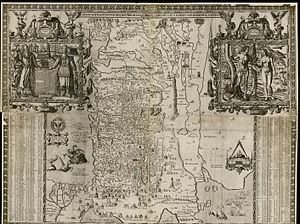
The Book of Joshua is the sixth book in the Hebrew Bible and the Old Testament, and is the first book of the Deuteronomistic history, the story of Israel from the conquest of Canaan to the Babylonian exile. It tells of the campaigns of the Israelites in central, southern and northern Canaan, the destruction of their enemies, and the division of the land among the Twelve Tribes, framed by two set-piece speeches, the first by God commanding the conquest of the land, and, at the end, the second by Joshua warning of the need for faithful observance of the Law (torah) revealed to Moses.

The Book of Jonah is one of the twelve minor prophets of the Nevi'im ("Prophets") in the Hebrew Bible, and an individual book in the Christian Old Testament. The book tells of a Hebrew prophet named Jonah, son of Amittai, who is sent by God to prophesy the destruction of Nineveh, but attempts to escape his divine mission.

Jonah or Jonas is a prophet in the Hebrew Bible, hailing from Gath-hepher in the Kingdom of Israel around the 8th century BCE. He is the central figure of the Book of Jonah, which details his reluctance in delivering the judgment of Yahweh unto the city of Nineveh in Assyria. After he is swallowed by a large sea creature and then released, he returns to the divine mission.

According to the Hebrew Bible, the tribe of Judah was one of the twelve Tribes of Israel, named after Judah, the son of Jacob. Judah was the first tribe to take its place in the Land of Israel, occupying the southern part of the territory. Jesse and his sons, including King David, belonged to this tribe.
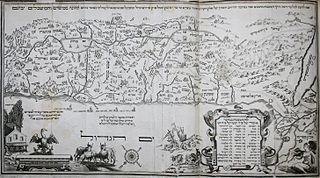
According to the Hebrew Bible, the Tribe of Ephraim was one of the tribes of Israel. The Tribe of Manasseh together with Ephraim formed the House of Joseph. It is one of the ten lost tribes. The etymology of the name is disputed.

According to the Hebrew Bible, the Tribe of Manasseh was one of the Tribes of Israel. It is one of the ten lost tribes. Together with the Tribe of Ephraim, Manasseh also formed the House of Joseph.

Lucas van Leyden, also named either Lucas Hugensz or Lucas Jacobsz, was a Dutch painter and printmaker in engraving and woodcut. Lucas van Leyden was among the first Dutch exponents of genre painting and was a very accomplished engraver.

According to the Hebrew Bible, the Kenites/Qenites were a tribe in the ancient Levant. They settled in the towns and cities in the northeastern Negev in an area known as the "Negev of the Kenites" near Arad, and played an important role in the history of ancient Israel. One of the most recognized Kenites is Jethro, Moses's father-in-law, who was a shepherd and a priest in the land of Midian Judges 1:16 Certain groups of Kenites settled among the Israelite population, including the descendants of Moses's brother-in-law, although the Kenites descended from Rechab maintained a distinct, nomadic lifestyle for some time.
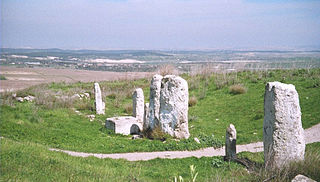
Gezer, or Tel Gezer, in Arabic: تل الجزر – Tell Jezar or Tell el-Jezari is an archaeological site in the foothills of the Judaean Mountains at the border of the Shfela region roughly midway between Jerusalem and Tel Aviv. It is now an Israeli national park. In the Hebrew Bible, Gezer is associated with Joshua and Solomon.
The Quran contains references to more than fifty people and events also found in the Bible. While the stories told in each book are generally comparable, there are also some notable differences. Knowing that versions of these stories written in the Hebrew Bible and the Christian New Testament did exist before the Quran, scholars consider similarities between these Islamic, Jewish and Christian texts. Muslims believe the Quran to be direct knowledge from the Creator of existence. As such, some Muslims believe that the earlier versions are distorted through flawed processes of transmission and interpretation over time, and consider the Quran's version to be more accurate.

Young Hare is a 1502 watercolour and bodycolour painting by German artist Albrecht Dürer. Painted in 1502 in his workshop, it is acknowledged as a masterpiece of observational art alongside his Great Piece of Turf from the following year. The subject is rendered with almost photographic accuracy, and although the piece is normally given the title Young Hare, the portrait is sufficiently detailed for the hare to be identified as a mature specimen — the German title translates as "Field Hare" and the work is often referred to in English as the Hare or Wild Hare.
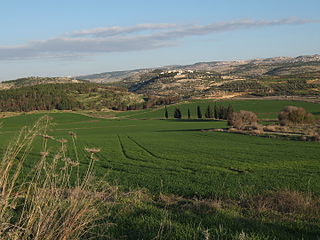
The Land of Israel is the traditional Jewish name for an area of the Southern Levant. Related biblical, religious and historical English terms include the Land of Canaan, the Promised Land, the Holy Land, and Palestine. The definitions of the limits of this territory vary between passages in the Hebrew Bible, with specific mentions in Genesis 15, Exodus 23, Numbers 34 and Ezekiel 47. Nine times elsewhere in the Bible, the settled land is referred as "from Dan to Beersheba", and three times it is referred as "from the entrance of Hamath unto the brook of Egypt".
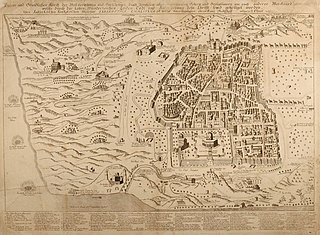
De-Pierre Map is an ancient map of the city of Jerusalem which was drawn by and signed in Latin : De Pierre Eques SSmi Sepulchri in 1728. De Pierre a French pilgrim an Equestrian Knight of the Holy Sepulchre.
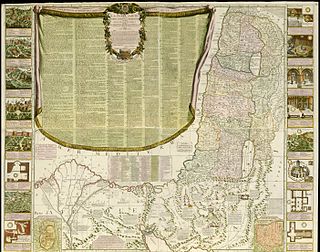
Nolin Map is a historic map of the Land of Israel and the city of Jerusalem which was drawn by the French cartographer and geographer Jean-Baptiste Nolin in 1700.

The Bünting Clover Leaf Map, also known as The World in a Cloverleaf, is a historic mappa mundi drawn by the German Protestant pastor, theologian, and cartographer Heinrich Bünting. The map was published in his book Itinerarium Sacrae Scripturae in 1581.
The cartography of the region of Palestine, also known as cartography of the Holy Land and cartography of the Land of Israel, is the creation, editing, processing and printing of maps of the region of Palestine from ancient times until the rise of modern surveying techniques. For several centuries during the Middle Ages it was the most prominent subject in all of cartography, and it has been described as an "obsessive subject of map art".

According to the Hebrew Bible, the Tribe of Reuben was one of the twelve tribes of Israel. Unlike the majority of the tribes, the land of Reuben, along with that of Gad and half of Manasseh, was on the eastern side of the Jordan and shared a border with Moab. According to the biblical narrative, the Tribe of Reuben descended from Reuben, the eldest son of the patriarch Jacob. Reuben, along with nine other tribes, is reckoned by the Bible as part of the northern kingdom of Israel, and disappears from history with the demise of that kingdom in c. 723 BC.

According to the Hebrew Bible, the Tribe of Issachar was one of the twelve tribes of Israel and one of the ten lost tribes. In Jewish tradition, the descendants of Issachar were seen as being dominated by religious scholars and influential in proselytism. The sons of Issachar, ancestors of the tribe, were Tola, Phuvah, Job and Shimron.

According to the Bible, the Tribe of Gad was one of the Twelve Tribes of Israel who, after the Exodus from Egypt, settled on the eastern side of the Jordan River. It is one of the ten lost tribes. The Tribe of Gad still originated from the original Hebrew Israelites.

According to the Torah, the Tribe of Benjamin was one of the Twelve Tribes of Israel. The tribe was descended from Benjamin, the youngest son of the patriarch Jacob and his wife Rachel. In the Samaritan Pentateuch the name appears as Binyamīm.
